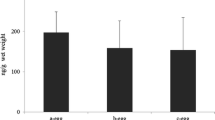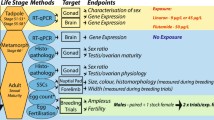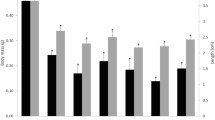Abstract
Perfluorobutanesulfonate (PFBS), as a substitute for perfluorooctanesulfonate (PFOS), is widespread in the environment and biotic samples as well as PFOS. To investigate effects of PFOS and PFBS on the growth and sexual development of amphibians, we exposed Xenopus laevis tadpoles at a series of concentrations of PFOS and PFBS (0.1; 1; 100; 1,000 μg/l) as well as 17-beta-estradiol (E2, 100 ng/l) and 5 alpha-androstan-17-beta-ol-3-one (DHT, 100 ng/l) from stage 46/47 to 2 months postmetamorphosis. We found that neither PFOS nor PFBS had a significant effect on the survival and growth. However, they caused hepatohistological impairment at higher concentrations (100; 1,000 μg/l). Unlike E2, PFOS at all concentrations did not alter the sex ratio and induce intersex, but caused degeneration of spermatogonia in testes except for the lowest concentration. PFBS had no effect on the sex ratio and gonadal histology. PFOS and PFBS promoted expression of estrogen receptor (ER) and androgen receptor (AR), but not affected aromatase expression in the brain. The increase in expression of ER and AR suggests an increase in the responsiveness to the corresponding sex hormone and potential effects on sexual development. Our results show that PFBS as well as PFOS have adverse effects on hepato-histology and sexual development on X. laevis. Also, PFOS- and PFBS-induced increase in ER and AR expression highlights the need to further study effects of PFOS and PFBS on subsequently gonadal development, sexual dimorphism, and secondary sex characteristics in X. laevis. It is debatable that PFBS is widely used as a substitute of PFOS.





Similar content being viewed by others
References
Ankley GT, Kuehl DW, Kahl MD, Jensen KM, Linnum A, Leino RL, Villeneuvet DA (2005) Reproductive and developmental toxicity and bioconcentration of perfluorooctanesulfonate in a partial life-cycle test with the fathead minnow (Pimephales promelas). Environ Toxicol Chem 24(9):2316–2324
Bagamasbad P, Denver RJ (2011) Mechanisms and significance of nuclear receptor auto- and cross-regulation. Gen Comp Endocrinol 170(1):3–17
Bijland S, Rensen PC, Pieterman EJ, Maas AC, van der Hoorn JW, van Erk MJ, Havekes LM, van Dijk KW, Chang SC, Ehresman DJ, Butenhoff JL, Princen HM (2011) Perfluoroalkyl sulfonates cause alkyl chain length-dependent hepatic steatosis and hypolipidemia mainly by impairing lipoprotein production in APOE*3-Leiden CETP mice. Toxicol Sci 123(1):290–303
Bjork JA, Lau C, Chang SC, Butenhoff JL, Wallace KB (2008) Perfluorooctane sulfonate-induced changes in fetal rat liver gene expression. Toxicology 251(1–3):8–20
Bjork JA, Butenhoff JL, Wallace KB (2011) Multiplicity of nuclear receptor activation by PFOA and PFOS in primary human and rodent hepatocytes. Toxicology 288(1–3):8–17
Bogi C, Levy G, Lutz I, Kloas W (2002) Functional genomics and sexual differentiation in amphibians. Comp Biochem Physiol B 133:559–570
Butenhoff JL, Olsen GW, Pfahles-Hutchens A (2006) The applicability of biomonitoring data for perfluorooctanesulfonate to the environmental public health continuum. Environ Health Perspect 114(11):1776–1782
Butenhoff JL, Ehresman DJ, Chang SC, Parker GA, Stump DG (2009) Gestational and lactational exposure to potassium perfluorooctanesulfonate (K + PFOS) in rats: developmental neurotoxicity. Reprod Toxicol 27(3–4):319–330
Cevasco A, Urbatzka R, Bottero S, Massari A, Pedemonte F, Kloas W, Mandich A (2008) Endocrine disrupting chemicals (EDC) with (anti)estrogenic and (anti)androgenic modes of action affecting reproductive biology of Xenopus laevis: II. Effects on gonad histomorphology. Comp Biochem Physiol 147(2):241–251
Chang CY, Witschi E (1956) Genic control and hormonal reversal of sex differentiation in Xenopus. Proc Soc Exp Biol Med 93(1):140–144
Cheng Y, Cui Y, Chen HM, Xie WP (2011) Thyroid disruption effects of environmental level perfluorooctane sulfonates (PFOS) in Xenopus laevis. Ecotoxicology 20(8):2069–2078
Cui L, Zhou QF, Liao CY, Fu JJ, Jiang GB (2009) Studies on the toxicological effects of PFOA and PFOS on rats using histological observation and chemical analysis. Arch Environ Contam Toxicol 56(2):338–349
Dennis C (2004) Brain development: the most important sexual organ. Nature 427(6973):390–392
DeWitt JC, Shnyra A, Badr MZ, Loveless SE, Hoban D, Frame SR, Cunard R, Anderson SE, Meade BJ, Peden-Adams MM, Luebke RW, Luster MI (2009) Immunotoxicity of perfluorooctanoic acid and perfluorooctane sulfonate and the role of peroxisome proliferator-activated receptor alpha. Crit Rev Toxicol 39(1):76–94
D’Hollander W, de Voogt P, De Coen W, Bervoets L (2010) Perfluorinated substances in human food and other sources of human exposure. Rev Environ Contam Toxicol 208:179–215
Du Y, Shi X, Liu C, Yu K, Zhou B (2009) Chronic effects of water-borne PFOS exposure on growth, survival and hepatotoxicity in zebrafish: a partial life-cycle test. Chemosphere 74(5):723–729
Duarte-Guterman P, Trudeau VL (2010) Regulation of thyroid hormone-, oestrogen- and androgen-related genes by triiodothyronine in the brain of Silurana tropicalis. J Neuroendocrinol 22(9):1023–1031
Elcombe CR, Elcombe BM, Foster JR, Chang SC, Ehresman DJ, Butenhoff JL (2012) Hepatocellular hypertrophy and cell proliferation in Sprague-Dawley rats from dietary exposure to potassium perfluorooctanesulfonate results from increased expression of xenosensor nuclear receptors PPAR alpha and CAR/PXR. Toxicology 293(1–3):16–29
Fang C, Wu X, Huang Q, Liao Y, Liu L, Qiu L, Shen H, Dong S (2012) PFOS elicits transcriptional responses of the ER, AHR and PPAR pathways in Oryzias melastigma in a stage-specific manner. Aquat Toxicol 106–107:9–19
Gallien L (1953) Inversion totale du sexe chez Xenopus laevis Daud a la suite dun traitement gynogene par le benzoate doestradiol, administre pendant la vie larvaire. CR Hebd Acad Sci 237(23):1565–1566
Gallien L (1956) Inversion experimentale du sexe chez un anoure inferieur Xenopus laevis Daudin. Analyse des consequences genetiques. Bull Biol Fr Belg 90:163–183
Gibbons A (1991) The brain as sexual organ. Science 253(5023):957–959
Guerriero G, Roselli CE, Paolucci M, Botte V, Ciarcia G (2000) Estrogen receptors and aromatase activity in the hypothalamus of the female frog, Rana esculenta. Fluctuations throughout the reproductive cycle. Brain Res 880(1–2):92–101
Guerriero G, Prins GS, Birch L, Ciarcia G (2005) Neurodistribution of androgen receptor immunoreactivity in the male frog, Rana esculenta. Ann N Y Acad Sci 1040:332–336
Hagenaars A, Knapen D, Meyer IJ, van der Ven K, Hoff P, De Coen W (2008) Toxicity evaluation of perfluorooctane sulfonate (PFOS) in the liver of common carp (Cyprinus carpio). Aquat Toxicol 88(3):155–163
Hagenaars A, Vergauwen L, De Coen W, Knapen D (2011) Structure–activity relationship assessment of four perfluorinated chemicals using a prolonged zebrafish early life stage test. Chemosphere 82(5):764–772
Han J, Fang Z (2010) Estrogenic effects, reproductive impairment and developmental toxicity in ovoviparous swordtail fish (Xiphophorus helleri) exposed to perfluorooctane sulfonate (PFOS). Aquat Toxicol 99(2):281–290
Hayes TB, Khoury V, Narayan A, Nazir M, Park A, Brown T, Adame L, Chan E, Buchholz D, Stueve T, Gallipeau S (2010) Atrazine induces complete feminization and chemical castration in male African clawed frogs (Xenopus laevis). Proc Natl Acad Sci 107(10):4612–4617
Hekster FM, Laane RWPM, de Voogt P (2003) Environmental and toxicity effects of perfluoroalkylated substances. Rev Environ Contam Toxicol 179:99–121
Henry ND, Fair PA (2011) Comparison of in vitro cytotoxicity, estrogenicity and anti-estrogenicity of triclosan, perfluorooctane sulfonate and perfluorooctanoic acid. J Appl Toxicol 33(4):265–272
Holzer J, Midasch O, Rauchfuss K, Kraft M, Reupert R, Angerer J, Kleeschulte P, Marschall N, Wilhelm M (2008) Biomonitoring of perfluorinated compounds in children and adults exposed to perfluorooctanoate-contaminated drinking water. Environ Health Perspect 116(5):651–657
Ji K, Kim Y, Oh S, Ahn B, Jo H, Choi K (2008) Toxicity of perfluorooctane sulfonic acid and perfluorooctanoic acid on freshwater macroinvertebrates (Daphnia magna and Moina macrocopa) and fish (Oryzias latipes). Environ Toxicol Chem 27(10):2159–2168
Keiter PA, Gamboa EJ, Huntington CM, Kuranz CC (2012) Concept to diagnose mix with imaging X-ray Thomson scattering. Rev Sci Instrum 83(10):10E534
Kelley FN (1992) Industry–university cooperation in polymer research. Abstr Pap Am Chem Soc 204:88
Lieder PH, Chang SC, York RG, Butenhoff JL (2009) Toxicological evaluation of potassium perfluorobutanesulfonate in a 90-day oral gavage study with Sprague-Dawley rats. Toxicology 255(1–2):45–52
Newsted JL, Beach SA, Gallagher SP, Giesy JP (2008) Acute and chronic effects of perfluorobutane sulfonate (PFBS) on the mallard and northern bobwhite quail. Arch Environ Contam Toxicol 54(3):535–545
Nieuwkoop PD, Faber J (1994) Normal table of Xenopus laevis, 2nd edn. Garland, New York
Olmstead AW, Korte JJ, Woodis KK, Bennett BA, Ostazeski S, Degitz SJ (2009) Reproductive maturation of the tropical clawed frog: Xenopus tropicalis. Gen Comp Endocrinol 160(2):117–123
Olsen GW, Chang SC, Noker PE, Gorman GS, Ehresman DJ, Lieder PH, Butenhoff JL (2009) A comparison of the pharmacokinetics of perfluorobutanesulfonate (PFBS) in rats, monkeys, and humans. Toxicology 256(1–2):65–74
Onishchenko AL, Kolbasko AV, Chernysheva AD, Surzhikova GS, Dantsiger OV (2011) Plasmapheresis combined with cell mass ozonation in endogenous uveitis treatment. Vestn Oftalmol 127(6):32–35
Paolucci M (2003) An androgen receptor in the brain of the green frog Rana esculenta. Life Sci 73(3):265–274
Perez J, Cohen MA, Kelley DB (1996) Androgen receptor mRNA expression in Xenopus laevis CNS: sexual dimorphism and regulation in laryngeal motor nucleus. J Neurobiol 30(4):556–568
Porter KL, Olmstead AW, Kumsher DM, Dennis WE, Sprando RL, Holcombe GW, Korte JJ, Lindberg-Livingston A, Degitz SJ (2011) Effects of 4-tert-octylphenol on Xenopus tropicalis in a long term exposure. Aquat Toxicol 103(3–4):159–169
Qin ZF, Zhou JM, Chu SG, Xu XB (2003) Effects of Chinese domestic polychlorinated biphenyls (PCBs) on gonadal differentiation in Xenopus laevis. Environ Health Perspect 111(4):553–556
Qin ZF, Qin XF, Yang L, Li HT, Zhao XR, Xu XB (2007) Feminizing/demasculinizing effects of polychlorinated biphenyls on the secondary sexual development of Xenopus laevis. Aquat Toxicol 84(3):321–327
Reiner JL, O’Connell SG, Moors AJ, Kucklick JR, Becker PR, Keller JM (2011) Spatial and temporal trends of perfluorinated compounds in beluga whales (Delphinapterus leucas) from Alaska. Environ Sci Technol 45(19):8129–8136
Rumsby PC, McLaughlin CL, Hall T (2009) Perfluorooctane sulphonate and perfluorooctanoic acid in drinking and environmental waters. Philos Trans R Soc A 367(1904):4119–4136
Sen A, Prizant H, Hammes SR (2011) Understanding extranuclear (nongenomic) androgen signaling: what a frog oocyte can tell us about human biology. Steroids 76(9):822–828
Spachmo B, Arukwe A (2011) Endocrine and developmental effects in Atlantic salmon (Salmo salar) exposed to perfluorooctane sulfonic or perfluorooctane carboxylic acids. Aquat Toxicol 108:112–124
State Science and Technology Commission in China (1988) Regulation for the administration of affairs concerning experimental animals. The Ministry of Science and Technology of the People’s Republic of China, Beijing
Suja F, Pramanik BK, Zain SM (2009) Contamination, bioaccumulation and toxic effects of perfluorinated chemicals (PFCs) in the water environment: a review paper. Water Sci Technol 60(6):1533–1544
Takase M, Iguchi T (2007) Molecular cloning of two isoforms of Xenopus (Silurana) tropicalis estrogen receptor mRNA and their expression during development. BBA Gene Struct Expr 1769(3):172–181
Tan YM, Clewell HJ, Andersen ME (2008) Time dependencies in perfluorooctylacids disposition in rat and monkeys: a kinetic analysis. Toxicol Lett 177(1):38–47
Villalpando I, Merchant-Larios H (1990) Determination of the sensitive stages for gonadal sex-reversal in Xenopus laevis tadpoles. Int J Dev Biol 34(2):281–285
Wang MY, Chen JF, Lin KF, Chen YH, Hu W, Tanguay RL, Huang CJ, Dong QX (2011) Chronic zebrafish PFOS exposure alters sex ratio and maternal related effects in F1 offspring. Environ Toxicol Chem 30(9):2073–2080
White SN, Jamnongjit M, Gill A, Lutz LB, Hammes SR (2005) Specific modulation of nongenomic androgen signaling in the ovary. Steroids 70(5–7):352–360
Zhao XL, Cai YQ, Wu FC, Pan YY, Liao HQ, Xu BB (2011) Determination of perfluorinated compounds in environmental water samples by high-performance liquid chromatography–electrospray tandem mass spectrometry using surfactant-coated Fe3O4 magnetic nanoparticles as adsorbents. Microchem J 98(2):207–214
Acknowledgments
This work was supported by Grants from Hi-Tech Research and Development Program of China (863 Plan) (2010AA 065105), Public Welfare Research Project (201109048, 201110250), and National Natural Science Foundation of China (21077125).
Conflict of interest
The authors declare that they have no conflict of interest.
Author information
Authors and Affiliations
Corresponding authors
Rights and permissions
About this article
Cite this article
Lou, QQ., Zhang, YF., Zhou, Z. et al. Effects of perfluorooctanesulfonate and perfluorobutanesulfonate on the growth and sexual development of Xenopus laevis . Ecotoxicology 22, 1133–1144 (2013). https://doi.org/10.1007/s10646-013-1100-y
Accepted:
Published:
Issue Date:
DOI: https://doi.org/10.1007/s10646-013-1100-y




